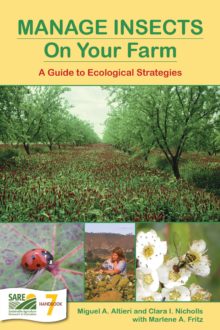Altieri, M. A. and C. I. Nicholls. 2005. Biodiversity and Pest Management in Agroecosystems. Haworth Press: New York, NY.
Andow, D. A. 1991. Vegetational diversity and arthropod population response. Annual Review of Entomology 36: 561-586.
Baliddawa, C. W. 1985. Plant species diversity and crop pest control: An analytical review. International Journal of Tropical Insect Science 6(4): 479- 489.
Belfrage, K., J. Björklund, and L. Salomonsson. 2005. The effects of farm size and organic farming on diversity of birds, pollinators, and plants in a Swedish landscape. Ambio 8(34): 582-588.
Benedek, P. 1996. Structure and density of lucerne pollinating wild bee populations as affected by changing agriculture. Acta Horticulturae 437: 353-357.
Bohart, G. E. 1972. Management of habitats for wild bees. Proceedings of the Tall Timbers Conference on Ecological Animal Control by Habitat Management 3: 253-266.
Carreck, N. L. and I. H. Williams. 2002. Food for insect pollinators on farmland: insect visits to flowers of annual seed mixtures. Journal of Insect Conservation 6(1): 13-23.
Goulson, D. 2003. Conserving wild bees for crop pollination. Food, Agriculture & Environment 1(1): 142-144.
Kearns, C. A. and D. W. Inouye. 1997. Pollinators, flowering plants, and conservation biology. BioScience 47(5): 297-307.
Kevan, P. G. 1999. Pollinators as bioindicators of the state of the environment: species, activity and diversity. Agriculture, Ecosystems and Environment 74(1-3): 373-393.
Kevan, P. G., E. A. Clark, and V. G. Thomas. 1990. Insect pollinators and sustainable agriculture. American Journal of Alternative Agriculture 5(1): 13-22.
Klein, A. M., B. E. Vaissière, J. H. Cane, I. Steffan-Dewenter, S. A. Cunningham, C. Kremen, and T. Tscharntke. 2007. Importance of pollinators in changing landscapes for world crops. Proc. R. Soc. Lon B Biol Sci 274(1608): 303–313.
Kremen, C., N. M. Williams, and R. W. Thorp. 2002. Crop pollination from native bees at risk from agricultural intensification. Proc. Natl Acad. Sci. USA 99(26): 16812–16.
Landis, D. A, F. D. Menalled, A. C. Costamagna, and T. K. Wilkinson. 2005. Manipulating plant resources to enhance beneficial arthropods in agricultural landscapes. Weed Science 53(6): 902-908.
Letourneau, D. K., I. Armbrecht, B. S. Rivera, J. M. Lerma, E. J. Carmona, M. C. Daza, S. Escobar, V. Galindo, C. Gutiérrez, S. D. López, J. L. Mejía, A. M. Acosta Rangel, J. H. Rangel, L. Rivera, C. A. Saavedra, A. M. Torres, and A. R. Trujillo. 2011. Does plant diversity benefit agroecosystems? A synthetic review. Ecological Applications 21: 9-21.
Mader, E., M. Shepherd, M. Vaughan, S. Black, and G. LeBuhn. 2011. Attracting Native Pollinators: Protecting North America’s Bees and Butterflies. Storey Publishing: North Adam, MA.
Morandin, L. A. and M. L. Winston. 2006. Pollinators provide economic incentive to preserve natural land in agroecosystems. Agriculture, Ecosystems and Environment 116(3-4): 289-292.
Nicholls, C. I. and M. A. Altieri. 2013. Plant biodiversity enhances bees and other insect pollinators in agroecosystems. A review. Agronomy for Sustainable Development 33(2): 257-274.
Poveda, K., M. I. Gomez, and E. Martinez. 2008. Diversification practices: their effect on pest regulation and production. Revista Colombiana de Entomología 34(2): 131-144.
Risch, S. J., D. Andow, and M. A. Altieri. 1983. Agroecosystem diversity and pest control: data, tentative conclusions, and new research directions. Environmental Entomology 12(3): 625–629.
Russell, E. P. 1989. Enemies hypothesis: a review of the effect of vegetational diversity on predatory insects and parasitoids. Environmental Entomology 18(4): 590-599.
Sheperd, M. D., S. L. Buchmann, M. Vaughan, and S. H. Black. 2003. Pollinator Conservation Handbook. Xerces Society: Portland, OR.
Shuler, R. E., T. H. Roulston, and G. E. Farris. 2005. Farming practices influence wild pollinator populations on squash and pumpkin. Journal of Economic Entomology 98(3): 790-795.
Steffan-Dewenter, I. 2002. Landscape context affects trap-nesting bees, wasps, and their natural enemies. Ecological Entomology 27(5): 631–637.
